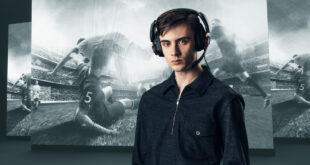We’ve always been passionate about audio. As we’ve grown, that’s the one thing that’s never changed. We try and bring it to everything we do, be it feature films, TV, commercials or video games.
Over the years, our work, particularly in TV and film, has been from local producers. This differs from our experience in video games, where conventional geographical workflow barriers are mostly ignored. This is perhaps because the industry is relatively young and geography isn’t seen as an obstacle.
The global talent-pool is embraced and that’s made it easier for us to work on projects with international clients. On Halo 4: Spartan Ops, it didn’t really matter that we were in Glasgow and 343 were in the USA. It’s all about a solid workflow, a realistic schedule and regular contact.
Our creative team has always comprised of sound designers and composers, but these disciplines are rarely allowed to cross over. Video games clients look at this multi-disciplined approach as a strength and embrace it. This has seen us, as a company, score, design and mix dozens of game cinematics. As soon as we have creative freedom on all aspects of the soundtrack, everything clicks. Our recent project, the Fable Legends announcement trailer, is a perfect example.
The client was keen for us to approach the project as a complete soundtrack, with constant collaboration between our composer, sound designer, mixer and the sound team at Lionhead. This allowed us continual experimentation with foley ideas and the ability to tweak the score and tonal environmental sounds so that when we came to the mix, everything just worked.
TELLING THE STORY
As a company that has a great track record in narrative storytelling, video games always seemed like a natural step for us. Our experience on feature film projects and the tradition of story-focussed soundtracks is something that we love to bring to games.
Our relationship with local studio Axis Animation has been a huge part of our growth in the industry. We’ve been working together for over a decade and it’s a really natural fit. They put a huge amount of trust in us to come up with sonic ideas that contribute to the storytelling, from first concepts through to the final mix.
As a creative relationship develops, projects become incredibly interesting. You develop a storytelling language that’s almost unique to you as a group. The more you work together, the less you need to discuss ideas or work through creative briefs. You just intuitively know what everyone will do and how they’ll interpret their part of the project.
On Halo 4: Spartan Ops, we had the opportunity to expand the Halo sonic universe. The audio team at 343 Industries supplied us with some key in-game sound effects, but we were given the freedom to develop these sounds within the context and confines of the franchise. Halo 4 was a last-gen game and there were the usual bandwidth limitations for in-game audio.
Luckily, we were working in a linear environment and had no real technical or creative barriers. Everything that moved, exploded, flew, kicked or punched was spotted with infinite detail.
The vehicles were the biggest challenge. The game engine does a great deal of the work when it comes to adding the physics of movement to in-game sound effects. Our challenge was to create the raw FX for spaceships such as a Pelican or Phantom and iconic vehicles like the Warthog, and then manipulate them realistically within each environment in such a way that the gamer didn’t spot the difference. We’re very excited at the sonic possibilities of next-gen consoles.
There is plenty of bandwidth for non-linear music and sound, which inevitably leads to more opportunities for experimentation and a better soundtrack. Linear and non-linear techniques are beginning to overlap. Products such as FMOD and Wwise allow sound designers and composers to use the same mixing and design philosophies used in films, but adapted to an interactive environment.
As tech breaks down barriers for working globally and allows for more audio bandwidth in games, we’re excited for the future and how we can be a defining part in it.
[This feature was published in the March 2014 edition of Develop magazine, which is available through your browser and on iPad. Watch out for more features on Scottish games development throughout this week.]

 MCV/DEVELOP News, events, research and jobs from the games industry
MCV/DEVELOP News, events, research and jobs from the games industry



